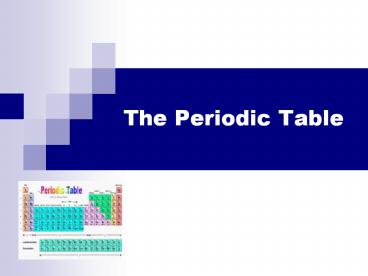The Periodic Table - PowerPoint PPT Presentation
1 / 17
Title:
The Periodic Table
Description:
The Periodic Table A. History of the Periodic Table 1. First developed by Dmitri Mendeleev in 1869. 2. Mendeleev was looking for a way to arrange the elements. – PowerPoint PPT presentation
Number of Views:109
Avg rating:3.0/5.0
Title: The Periodic Table
1
The Periodic Table
2
A. History of the Periodic Table
- 1. First developed by Dmitri Mendeleev in 1869.
- 2. Mendeleev was looking for a way to arrange the
elements. - 3. As he studied properties such as atomic mass,
he noticed a repeating pattern.
3
Side Note What does Periodic mean??
- Periodic means repeated in a pattern!
- HOWEVER, Mendeleev had to leave some spaces
because not all elements lined up according to
atomic mass. Notice that he used his information
to PREDICT masses. Very scientific!
4
B. The Modern Periodic Table
- 1. c. 1914 Henry G.J. Moseley realized that
elements could be arranged according to atomic
NUMBER rather than mass.
5
2. Seaborg (1944)
- a. rearranged Periodic Table with...
- Lanthanide and Actinide Series pulled
out/separated from main Periodic Table - b. discovered 10 new elements countless isotopes
6
B. Arrangement of the PT
16
18
1
- 1. The boxes are arranged into vertical columns
called groups or families. They are numbered 1 -
18. - a. The group numbers tell us the number of
electrons in that elements outer energy level -
the number in red
2
15
17
14
13
7
b. valence electrons
- electrons found in the outermost energy level
8
c. Octet Rule
- We just said that the red number in the
family/group number the number of electrons in
the outer shell or valency. - Octet Rule The tendency of atoms to gain or lose
electrons so they acquire eight electrons in
their outer energy level.
9
d. Groups to Know
- Group 1 - Alkali Metals
- Group 2 - Alkaline Earth Metals
- Group 17 - Halogens
- Group 18 - Noble Gases
10
2. Periods
- a. The boxes are arranged into horizontal rows
called periods. - b. The period numbers tell us the number of
energy levels that an atom has - c. Periods are numbered 1 through 7
1
2
3
4
5
6
7
11
3. Regions of the Periodic Table
- a. Metals - to the left of the stair-step line
- b. Non-Metals - to the right of the stair-step
line - c. Metalloids - on the stair-step line
12
a. Metals
- Found to LEFT of zigzag line on table
- Good conductors of heat electricity
- Malleable
- Ductile
- High melting points
- Shiny
- Tend to lose electrons
13
b. Nonmetals
- Found to RIGHT of zigzag line on table
- Poor conductors of heat electricity
- Brittle when solid
- Dull
- Low melting points
- Tend to gain electrons
14
c. Metalloids/Semi-Metals
- Found along both sides of zigzag line
- Properties of both metals nonmetals
- Okay conductors of heat electricity
- Shiny or dull
15
C. Trends in the Periodic Table
- Valence number
- Charge of ion (positive or negative)
- Tendency to gain or lose electrons
- Metallic vs. nonmetallic properties
- Atomic size (radius)
- Ionization energy
- Electronegativity (which ones WANT electrons the
most)
16
1. Across a Period
- radius decreases (size of atom gets smaller)
- ionization energy increases
- electronegativity increases
- b/c
- number of valence electrons increases
- so EMF increases
- so valence electrons held more tightly
17
2. Down a Family
- radius increases
- ionization energy decreases
- electronegativity decreases
- b/c
- number of energy levels increases
- so valence electrons held less tightly































